Epidemiological Study on Health Risk Assessment of Exposure to PM2.5-Bound Toxic Metals in the Industrial Metropolitan of Rayong, Thailand
Abstract
:1. Introduction
2. Materials and Methods
2.1. Sampling Site
2.2. PM2.5 Sampling
2.3. Extraction and Analysis of PM2.5-Bound Elements
2.4. Morphology of PM2.5
2.5. Source Identification of PM2.5 Using Principal Component Analysis (PCA)
2.6. Statistical Analysis
2.7. Health Risk Assessment for Heavy Metals
2.7.1. Non-Carcinogenic Risk Assessment
2.7.2. Lung Cancer Risks
3. Results and Discussion
3.1. PM2.5 Concentrations
| Sampling Sites | Duration | PM2.5 (µg/m3) | Elements Concentrations (ng/m3) | Ref. | ||||||||||
|---|---|---|---|---|---|---|---|---|---|---|---|---|---|---|
| As | Cd | Cr | Cu | Fe | K | Mn | Ni | Pb | V | Zn | ||||
| Urban–Industrial area in Rayong, Thailand (n = 88) | Mean ± SD | 20.1 ± 10.9 | 0.84 ± 0.65 | 1.24 ± 2.32 | 18.9 ± 8.2 | 6.63 ± 6.58 | 248 ± 381 | 438 ± 301 | 20.1 ± 29.9 | 3.13 ± 5.49 | 28.5 ± 47.8 | 0.65 ± 0.55 | 553 ± 1040 | This work |
| Range | 4.9–52.3 | n.d.–2.91 | n.d.–12.9 | n.d.–67.7 | n.d.–39.4 | n.d.–2811 | 7.1–1398 | n.d.–196 | n.d.–27.4 | n.d.–350 | n.d.–3.53 | n.d.–7223 | ||
| Median | 17.0 | 0.88 | 0.42 | 18.5 | 4.78 | 140 | 350 | 11.5 | 1.14 | 13.6 | 0.52 | 254 | ||
| Urban–Industrial area in Kunming, China | 2013 to 2014 | 130 | 26.8 | 6.00 | 29.1 | 78.8 | - | - | 156 | 20.5 | 282 | 40.3 | 327 | Han et al. [5] |
| Industrial area in Khon Kaen, Thailand | December 2020 to February 2021 | 44.5 | - | 101 | - | 186 | 4.7 | - | 2296 | - | 273 | - | 4.5 | Sakunkoo et al. [7] |
| Industrial area in Kaohsiung, Taiwan | May 2015 to April 2018 | 25.3 | 1.07 | 0.679 | 6.59 | 8.31 | 216 | 198 | 15.4 | 9.43 | 18.9 | 18.0 | 125 | Hsu et al. [13] |
| Industrial area in Jiangjin, China | 6 to 28 Januanry 2019 | 97.1 | 7.56 | - | 4.29 | 15.8 | - | - | 58.6 | 1.39 | 37.9 | 0.60 | 94.2 | Han et al. [15] |
| Industry city in Karaj, Iran | 2018 to 2019 | 40.6 | 32.1 | 84.0 | 49.5 | 203 | - | - | 84.7 | 60.8 | 133 | - | 242 | Kermani et al. [17] |
| Urban–Industrial area in Xi’an, China | 2015 to 2016 | 50.6 | 116 | 16.5 | - | 41.3 | 33.7 | 10.6 | 34.1 | 6.00 | 200 | Liu et al. [32] | ||
| Urban–Industrial area in Taiyuan, China | 7 to 22 November 2016 | 147 | 7.07 | 7.60 | 175 | 161 | - | - | 218 | 96.2 | 498 | - | 513 | Liu et al. [33] |
| WHO guideline | 15 | 6.6 | 5 | 0.25 | 70 * | - | - | 150 | 25 | 500 | 1000 | - | WHO [36] | |
| Meteorological Factors | Temp | RH | Prec. | WS | PM2.5 |
|---|---|---|---|---|---|
| Temperature (°C) | 1 | ||||
| Relative Humidity (%) | 0.024 | 1 | |||
| Precipitation (mm) | −0.100 | 0.528 ** | 1 | ||
| Wind Speed (m/s) | −0.416 ** | −0.630 ** | −0.123 | 1 | |
| PM2.5 (µg/m3) | −0.253 * | −0.202 | −0.112 | 0.046 | 1 |
3.2. Heavy Metals and Elements Concentrations in PM2.5
3.3. Investigation of the Morphological and Elemental Characterization of PM2.5
3.4. Source Identification by Principal Component Analysis (PCA)
3.5. Health Risk Assessment of Heavy Metals
3.5.1. Non-Carcinogenic Risk Assessment for Heavy Metals
3.5.2. Lung Cancer Risk
4. Conclusions
Supplementary Materials
Author Contributions
Funding
Institutional Review Board Statement
Informed Consent Statement
Data Availability Statement
Acknowledgments
Conflicts of Interest
References
- World Health Organization (WHO). WHO Global Air Quality Guidelines, Particulate Matter (PM2.5 and PM10), Ozone, Nitrogen Dioxide, Sulfur Dioxide and Carbon Monoxide; WHO Press: Geneva, Switzerland, 2021; pp. 74–89. [Google Scholar]
- International Agency for Research on Cancer (IARC). Outdoor Air Pollution; IARC Monographs on the Evaluation of Carcinogenic Risks to Human; IARC Press: Lyon Cedex, France, 2013; p. 443. [Google Scholar]
- Li, C.Y.; Ding, M.; Yang, Y.; Zhang, P.; Li, Y.; Wang, Y.; Huang, L.; Yang, P.; Wang, M.; Sha, X.; et al. Portrait and classification of individual haze particulates. J. Environ. Prot. Sci. 2016, 7, 1355–1379. [Google Scholar] [CrossRef] [Green Version]
- Zhang, T.; Chen, Y.; Xu, X. Health risk assessment of PM2.5-bound components in Beijing, China during 2013–2015. Aerosol Air Qual. Res. 2020, 20, 1938–1949. [Google Scholar] [CrossRef]
- Han, X.; Li, S.; Li, Z.; Pang, X.; Bao, Y.; Shi, J.; Ning, P. Concentrations, source characteristics, and health risk assessment of toxic heavy metals in PM2.5 in a Plateau city (Kunming) in Southwest China. Int. J. Environ. Res. Public Health 2021, 18, 11004. [Google Scholar] [CrossRef] [PubMed]
- Xiao, K.; Wang, Q.; Lu, S.; Lin, Y.; Ebere Enyoh, C.; Chowdhury, T.; Rabin, M.H.; Islam, M.R.; Guo, Y.; Wang, W. Pollution levels and health risk assessment of potentially toxic metals of size-segregated particulate matter in rural residential areas of high lung cancer incidence in Fuyuan, China. Environ. Geochem. Health 2022. [Google Scholar] [CrossRef]
- Sakunkoo, P.; Thonglua, T.; Sangkham, S.; Jirapornkul, C.; Limmongkon, Y.; Daduang, S.; Tessiri, T.; Rayubkul, J.; Thongtip, S.; Maneenin, N.; et al. Human health risk assessment of PM2.5-bound heavy metal of anthropogenic sources in the Khon Kaen province of Northeast Thailand. Heliyon 2022, 8, e09572. [Google Scholar] [CrossRef] [PubMed]
- Sublett, J.L. Effectiveness of air filters and air cleaners in allergic respiratory diseases: A review of the recent literature. Curr. Allergy Asthma Rep. 2011, 11, 395–402. [Google Scholar] [CrossRef] [PubMed] [Green Version]
- Morishita, M.; Adar, S.D.; D’Souza, J.; Ziemba, R.A.; Bard, R.L.; Spino, C.; Brook, R.D. Effect of portable air filtration systems on personal exposure to fine particulate matter and blood pressure among residents in a low-income senior facility: A randomized clinical trial. JAMA Intern. Med. 2018, 178, 1350–1357. [Google Scholar] [CrossRef] [Green Version]
- Wang, P.; Liu, J.; Wang, C.; Zhang, Z.; Li, J. A holistic performance assessment of duct-type electrostatic precipitators. J. Clean. Prod. 2022, 357, 131997. [Google Scholar] [CrossRef]
- Chang, C.-C.; Chang, Y.-W.; Huang, P.-C. Effects of the INDC and GGRMA Regulations on the impact of PM2.5 particle emissions on Maritime ports: A study of human health and environmental costs. Sustainability 2022, 14, 6133. [Google Scholar] [CrossRef]
- Briffa, J.; Sinagra, E.; Blundell, R. Heavy metal pollution in the environment and their toxicological effects on humans. Heliyon 2020, 6, e04691. [Google Scholar] [CrossRef]
- Hsu, C.-Y.; Chi, K.-H.; Wu, C.-D.; Lin, S.-L.; Hsu, W.-C.; Tseng, C.-C.; Chen, M.-J.; Chen, Y.-C. Integrated analysis of source-specific risks for PM2.5-bound metals in urban, sub-urban, rural, and industrial areas. Environ. Pollut. 2021, 275, 116652. [Google Scholar] [CrossRef] [PubMed]
- Krupnova, T.G.; Rakova, O.V.; Bondarenko, K.A.; Saifullin, A.F.; Popova, D.A.; Potgieter-Vermaak, S.; Godoi, R.H.M. Elemental composition of PM2.5 and PM10 and health risks assessment in the industrial districts of Chelyabinsk, South Ural region, Russia. Int. J. Environ. Res. Public Health 2021, 18, 12354. [Google Scholar] [CrossRef] [PubMed]
- Han, Y.; Wang, Z.; Zhou, J.; Che, H.; Tian, M.; Wang, H.; Shi, G.; Yang, F.; Zhang, S.; Chen, Y. PM2.5-bound heavy metals in Southwestern China: Characterization, sources, and health risks. Atmosphere 2021, 12, 929. [Google Scholar] [CrossRef]
- Valko, M.; Morris, H.; Cronin, M.T.D. Metals, toxicity and oxidative stress. Curr. Med. Chem. 2005, 12, 1161–1208. [Google Scholar] [CrossRef] [PubMed] [Green Version]
- Kermani, M.; Jafari, A.J.; Gholami, M.; Arfaeinia, H.; Shahsavani, A.; Fanaei, F. Characterization, possible sources and health risk assessment of PM2.5-bound heavy metals in the most industrial city of Iran. J. Environ. Health Sci. Eng. 2021, 19, 151–163. [Google Scholar] [CrossRef] [PubMed]
- Niampradit, S.; Kliengchuay, W.; Mingkhwan, R.; Worakhunpiset, S.; Kiangkoo, N.; Sudsandee, S.; Hongthong, A.; Siriratruengsuk, W.; Muangsuwan, T.; Tantrakarnapa, K. The elemental characteristics and human health risk of PM2.5 during haze episode and non-haze episode in Chiang Rai province, Thailand. Int. J. Environ. Res. Public Health 2022, 19, 6127. [Google Scholar] [CrossRef] [PubMed]
- Eastern Economic Corridor (EEC). Available online: https://www.eeco.or.th/en (accessed on 1 September 2022).
- Xue, H.; Liu, G.; Zhang, H.; Hu, R.; Wang, X. Elemental composition, morphology and sources of fine particulates (PM2.5) in Hefei city, China. Aerosol Air Qual. Res. 2019, 19, 1688–1696. [Google Scholar] [CrossRef]
- Usman, F.; Zeb, B.; Alam, K.; Huang, Z.; Shah, A.; Ahmad, I.; Ullah, S. In-depth analysis of physicochemical properties of particulate matter (PM10, PM2.5 and PM1) and its characterization through FTIR, XRD and SEM-EDX techniques in the foothills of the Hindu Kush region of Northern Pakistan. Atmosphere 2022, 13, 124. [Google Scholar] [CrossRef]
- Zinatloo-Ajabshir, S.; Salavati-Niasari, M. Facile route to synthesize zirconium dioxide (ZrO2) nanostructures: Structural, optical and photocatalytic studies. J. Mol. Liq. 2016, 216, 545–551. [Google Scholar] [CrossRef] [Green Version]
- United State-Environmental Protection Agency (US-EPA). Available online: https://www.epa.gov/risk/regional-screening-levels-rsls-generic-tables (accessed on 10 August 2022).
- Yang, D.; Li, Z.; Yue, Z.; Liu, J.; Zhai, Z.; Li, Z.; Gao, M.; Hu, A.; Zhu, W.; Ding, N.; et al. Variations in sources, composition, and exposure risks of PM2.5 in both pre-heating and heating seasons. Aerosol Air Qual. Res. 2022, 22, 210333. [Google Scholar] [CrossRef]
- United State-Environmental Protection Agency (US-EPA). Risk Assessment Guidance for Superfund Volume I: Human health evaluation Manual (Part F, Supplemental Guidance for Inhalation Risk Assessment); US-EPA: Washington, DC, USA, 2009; p. 68.
- Greene, N.A.; Morris, V.R. Assessment of public health risk associated with atmospheric exposure to PM2.5 in Washington, DC, USA. Int. J. Environ. Res. Public Health 2006, 3, 86–97. [Google Scholar] [CrossRef] [PubMed]
- Gruszecka-Kosowska, A. Assessment of the Kraków inhabitants’ health risk caused by the exposure to inhalation of outdoor air contaminants. Stoch. Environ. Res. Risk Assess. 2018, 32, 485–499. [Google Scholar] [CrossRef] [Green Version]
- Feuyit, G.; Nzali, S.; Ngolui Lambi, J.; Laminsi, S. Air quality and human health risk assessment in the residential areas at the proximity of the Nkolfoulou landfill in Yaoundé metropolis, Cameroon. J. Chem. 2019, 2019, 3021894. [Google Scholar] [CrossRef] [Green Version]
- United State-Environmental Protection Agency (US-EPA). Exposure Factors Handbook, 2011th ed.; National Center for Environmental Assessment: Washington, DC, USA, 2011; p. 1436.
- National Air Quality Standards (NAAQs). Available online: https://www.transportpolicy.net/standard (accessed on 6 November 2022).
- Acid Deposition Monitoring Network in East Asia (EANET). Available online: https://www.eanet.asia (accessed on 6 November 2022).
- Liu, K.; Shang, Q.; Wan, C.; Song, P.; Ma, C.; Cao, L. Characteristics and sources of heavy metals in PM2.5 during a typical haze episode in rural and urban areas in Taiyuan, China. Atmosphere 2018, 9, 2. [Google Scholar] [CrossRef] [Green Version]
- Liu, P.; Zhang, Y.; Wu, T.; Shen, Z.; Xu, H. Acid-extractable heavy metals in PM2.5 over Xi’an, China: Seasonal distribution and meteorological influence. Environ. Sci. Pollut. Res. 2019, 26, 34357–34367. [Google Scholar] [CrossRef]
- Chithra, V.S.; Shiva Nagendra, S.M. Impact of outdoor meteorology on indoor PM10, PM2.5 and PM1 concentrations in a naturally ventilated classroom. Urban Clim. 2014, 10, 77–91. [Google Scholar]
- World Meteorological Organization (WMO). Available online: https://public.wmo.int/en/media/news/el-ni%C3%B1o-la-ni%C3%B1a-update-february-2022 (accessed on 10 August 2022).
- World Health Organization (WHO). Air Quality Guidelines for Europe; WHO Press: Copenhagen, Denmark, 2000; p. 288. [Google Scholar]
- Labrada-Delgado, G.; Aragon-Pina, A.; Campos-Ramos, A.; Castro-Romero, T.; Amador-Munoz, O.; Villalobos-Pietrini, R. Chemical and morphological characterization of PM2.5 collected during MILAGRO campaign using scanning electron microsopy. Atmos. Pollut. Res. 2012, 3, 289–300. [Google Scholar]
- Longhin, E.; Gualtieri, M.; Capasso, L.; Bengalli, R.; Mollerup, S.; Holme, J.A.; Øvrevik, J.; Casadei, S.; Di Benedetto, C.; Parenti, P.; et al. Physico-chemical properties and biological effects of diesel and biomass particles. Environ. Pollut. 2016, 215, 366–375. [Google Scholar] [CrossRef]
- Reid, J.S.; Koppmann, R.; Eck, T.F.; Eleuterio, D.P. A review of biomass burning emissions part II: Intensive physical properties of biomass burning particles. Atmos. Chem. Phys. 2005, 5, 799–825. [Google Scholar] [CrossRef] [Green Version]
- Ramli, N.A.; Shith, S.; Md Yusof, N.F.F.; Zarkasi, K.Z.; Suroto, A. Physicochemical characteristics of PM2.5 particles during high particulate event (HPE) in school area. IOP Conf. Ser. Earth Environ. Sci. 2020, 498, 012067. [Google Scholar] [CrossRef]
- Budaev, S.V. Using principal components and factor analysis in animal behaviour research: Caveats and guidelines. Ethology 2010, 116, 472–480. [Google Scholar] [CrossRef]
- Calace, N.; Ciardullo, S.; Petronio, B.M.; Pietrantonio, M.; Abbondanzi, F.; Campisi, T.; Cardellicchio, N. Influence of chemical parameters (heavy metals, organic matter, sulphur and nitrogen) on toxicity of sediments from the Mar Piccolo (Taranto, Ionian Sea, Italy). Microchem. J. 2005, 79, 243–248. [Google Scholar] [CrossRef]
- Ennouri, R.; Chouba, L.; Magni, P.; Kraiem, M.M. Spatial distribution of trace metals (Cd, Pb, Hg, Cu, Zn, Fe and Mn) and oligo-elements (Mg, Ca, Na and K) in surface sediments of the Gulf of Tunis (Northern Tunisia). Environ. Monit. Assess. 2009, 163, 229–239. [Google Scholar] [CrossRef] [PubMed]
- Tokalıoglu, Ş.; Kartal, Ş. Multivariate analysis of the data and speciation of heavy metals in street dust samples from the Organized Industrial District in Kayseri (Turkey). Atmos. Environ. 2006, 40, 2797–2805. [Google Scholar] [CrossRef]
- Bhuiyan, M.A.H.; Suruvi, N.I.; Dampare, S.B.; Islam, M.A.; Quraishi, S.B.; Ganyaglo, S.; Suzuki, S. Investigation of the possible sources of heavy metal contamination in lagoon and canal water in the tannery industrial area in Dhaka, Bangladesh. Environ. Monit. Assess. 2010, 175, 633–649. [Google Scholar] [CrossRef]
- Hjortenkrans, D.; Bergbäck, B.; Häggerud, A. New Metal Emission Patterns in Road Traffic Environments. Environ. Monit. Assess. 2006, 117, 85–98. [Google Scholar] [CrossRef]
- Ndiokwere, C.L. A study of heavy metal pollution from motor vehicle emissions and its effect on roadside soil, vegetation and crops in Nigeria. Environ. Pollut. Ser. B Chem. Phys. 1984, 7, 35–42. [Google Scholar] [CrossRef]
- Pandey, B.; Agrawal, M.; Singh, S. Assessment of air pollution around coal mining area: Emphasizing on spatial distributions, seasonal variations and heavy metals, using cluster and principal component analysis. Atmos. Pollut. Res. 2014, 5, 79–86. [Google Scholar] [CrossRef] [Green Version]
- Von Schneidemesser, E.; Stone, E.A.; Quraishi, T.A.; Shafer, M.M.; Schauer, J.J. Toxic metals in the atmosphere in Lahore, Pakistan. Sci. Total Environ. 2010, 408, 1640–1648. [Google Scholar] [CrossRef]
- Hong, N.; Zhu, P.F.; Liu, A.; Zhao, X.; Guan, Y.T. Using an innovative flag element ratio approach to tracking potential sources of heavy metals on urban road surfaces. Environ. Pollut. 2018, 243, 410–417. [Google Scholar] [CrossRef]
- Viana, M.; Querol, X.; Alastuey, A.; Gil, J.I.; Menéndez, M. Identification of PM sources by principal component analysis (PCA) coupled with wind direction data. Chemosphere 2006, 65, 2411–2418. [Google Scholar] [CrossRef] [PubMed]
- Slezakova, K.; Pereira, M.C.; Reis, M.A.; Alvim-Ferraz, M.C. Influence of traffic emissions on the composition of atmospheric particles of different sizes—Part 1: Concentrations and elemental characterization. J. Atmos. Chem. 2007, 58, 55–68. [Google Scholar] [CrossRef]
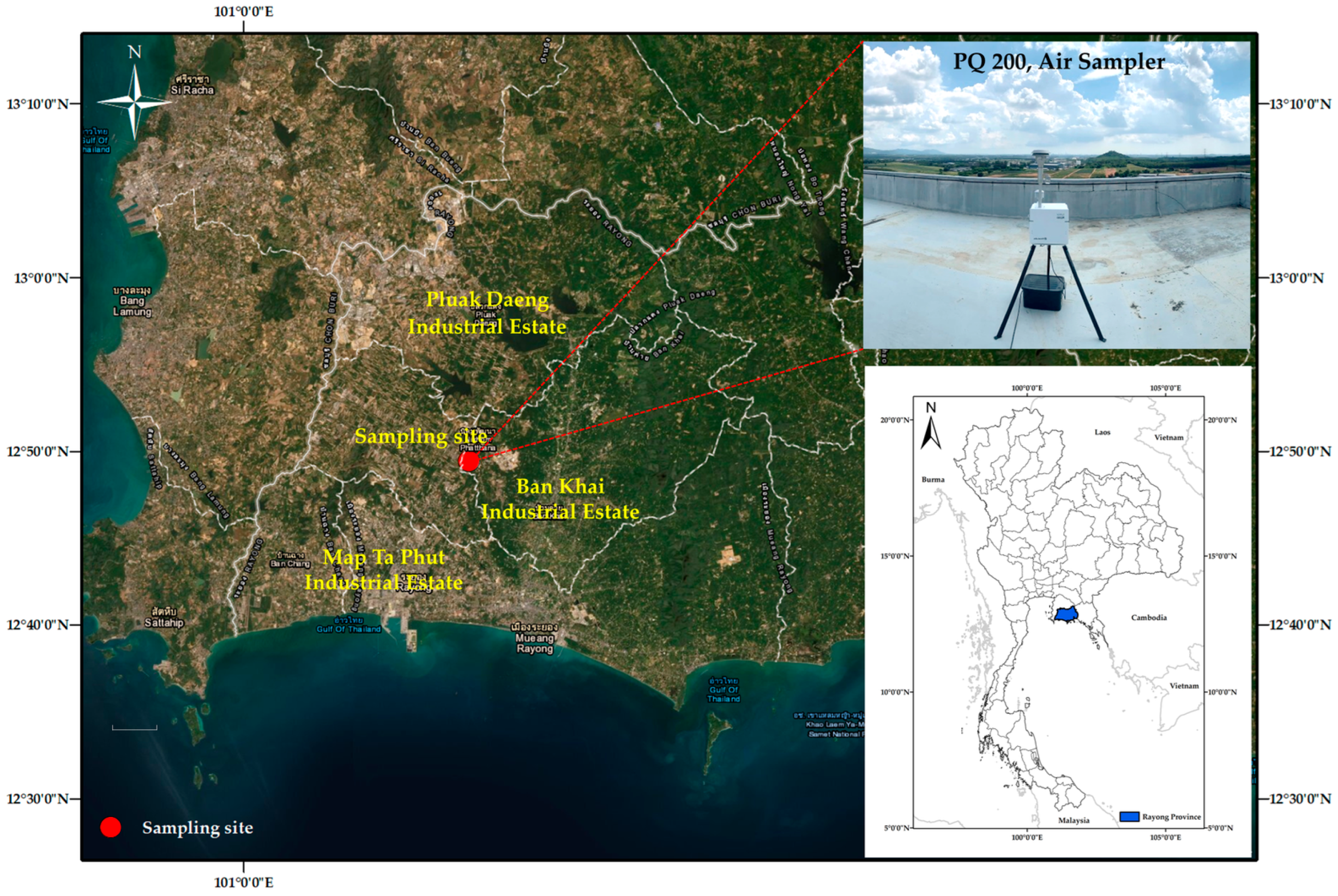
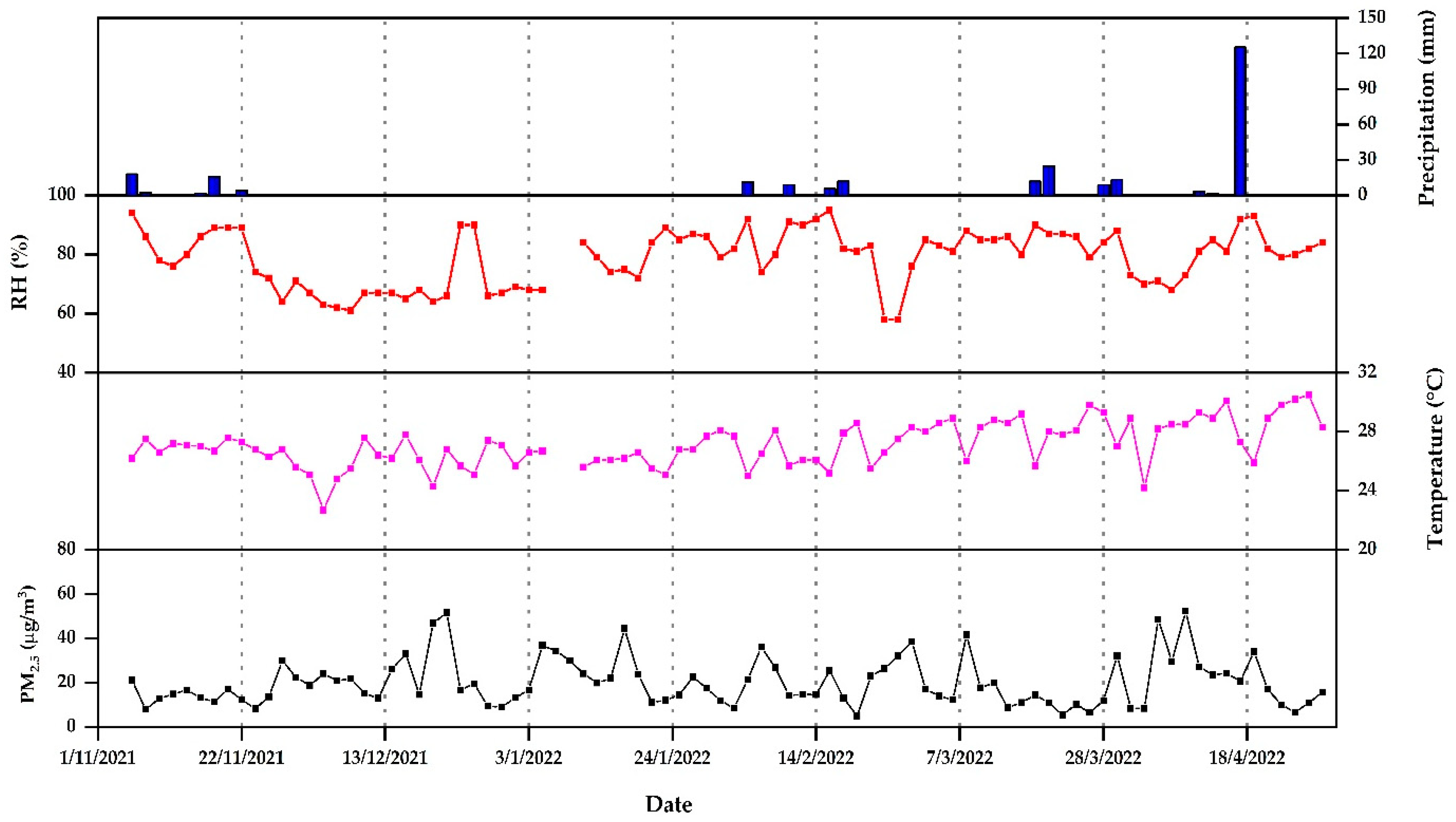
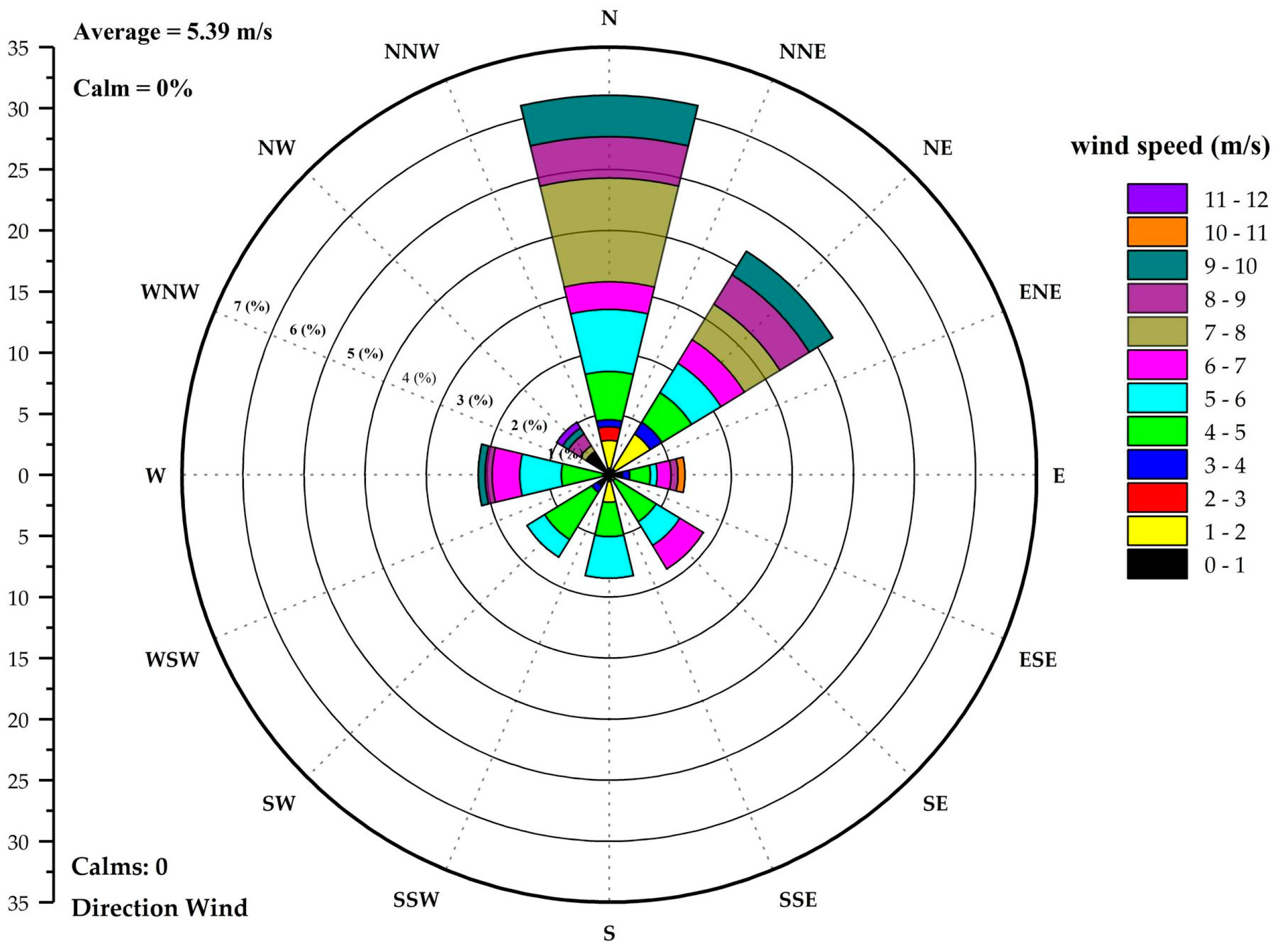
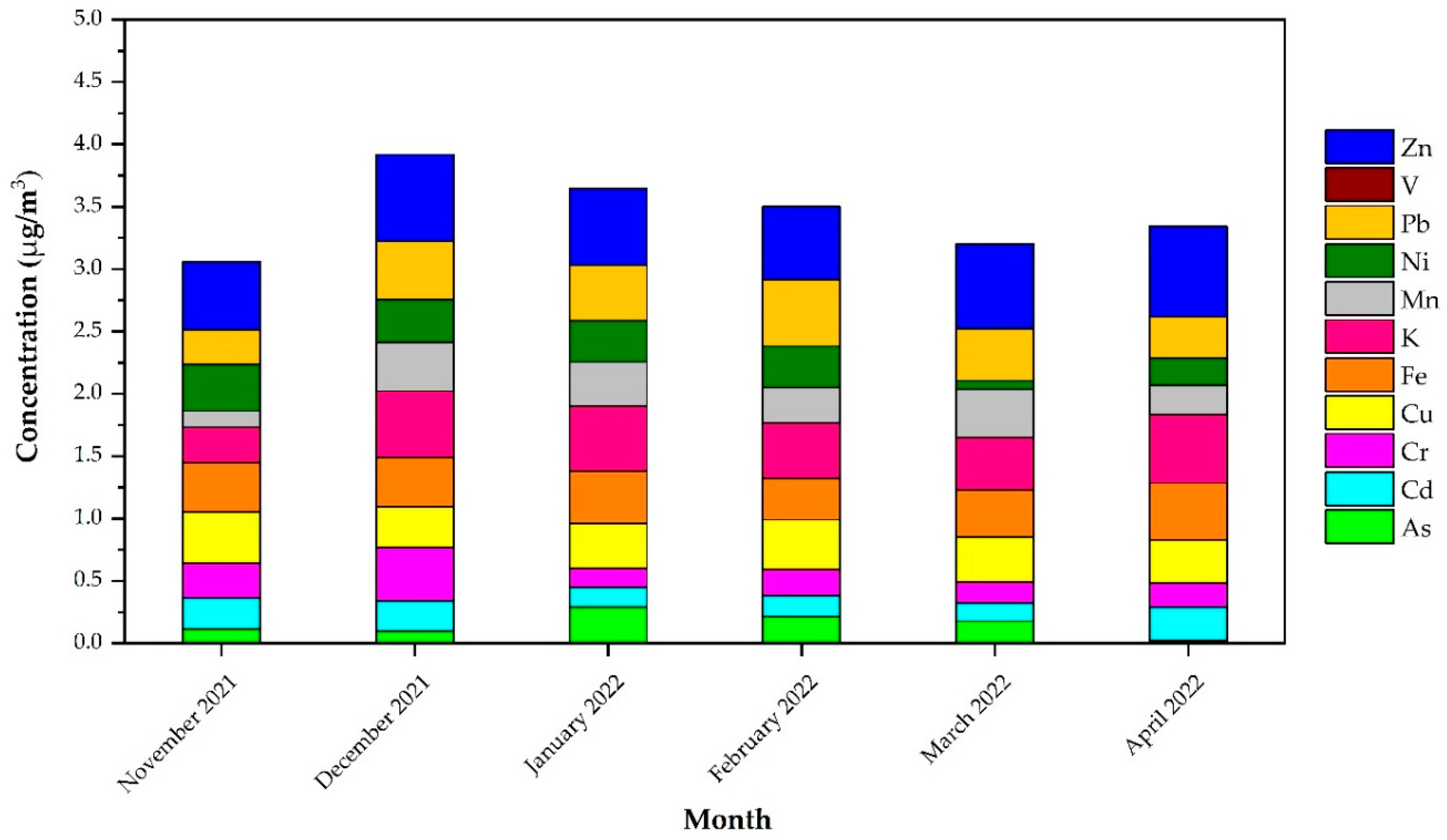
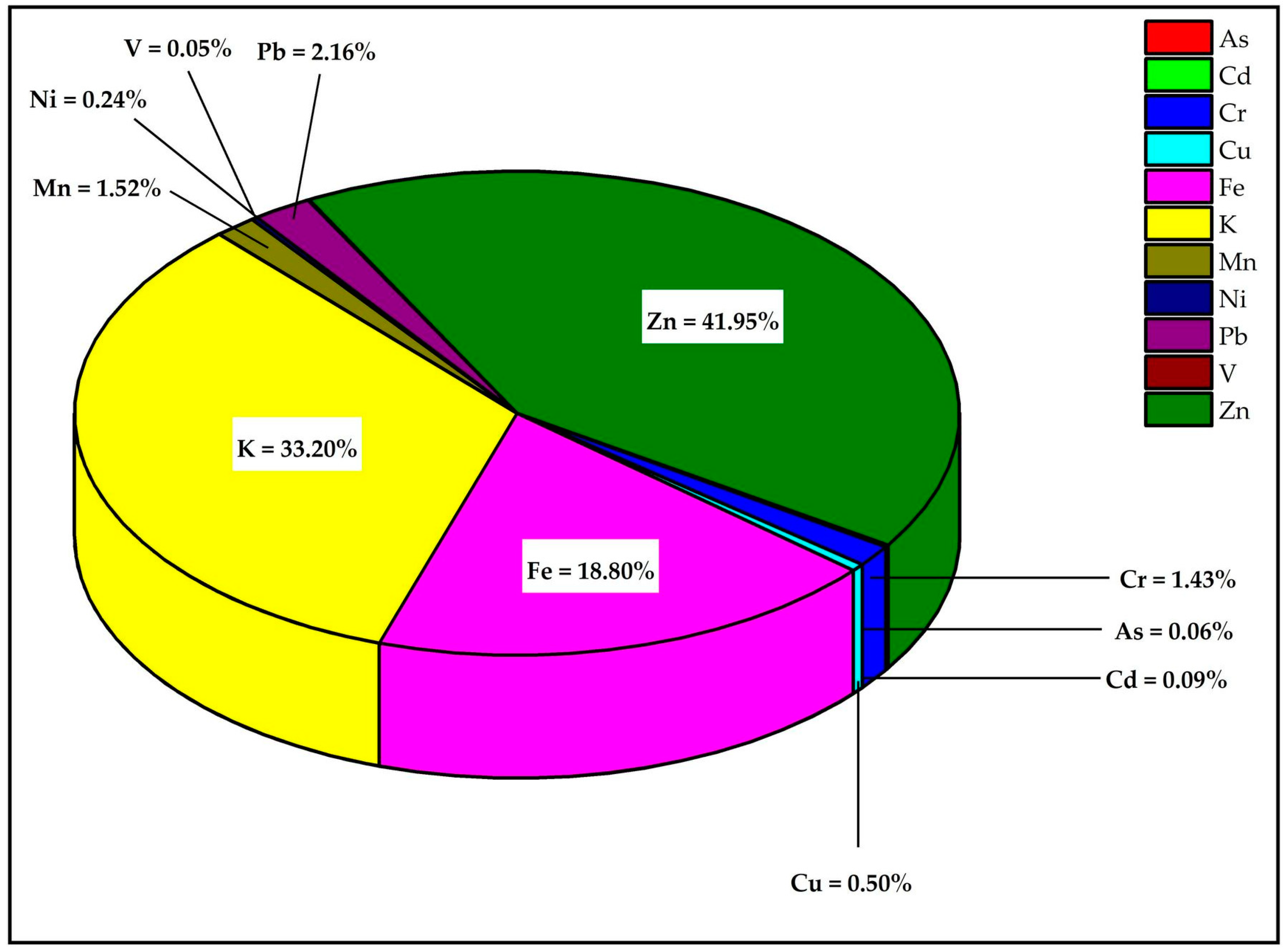
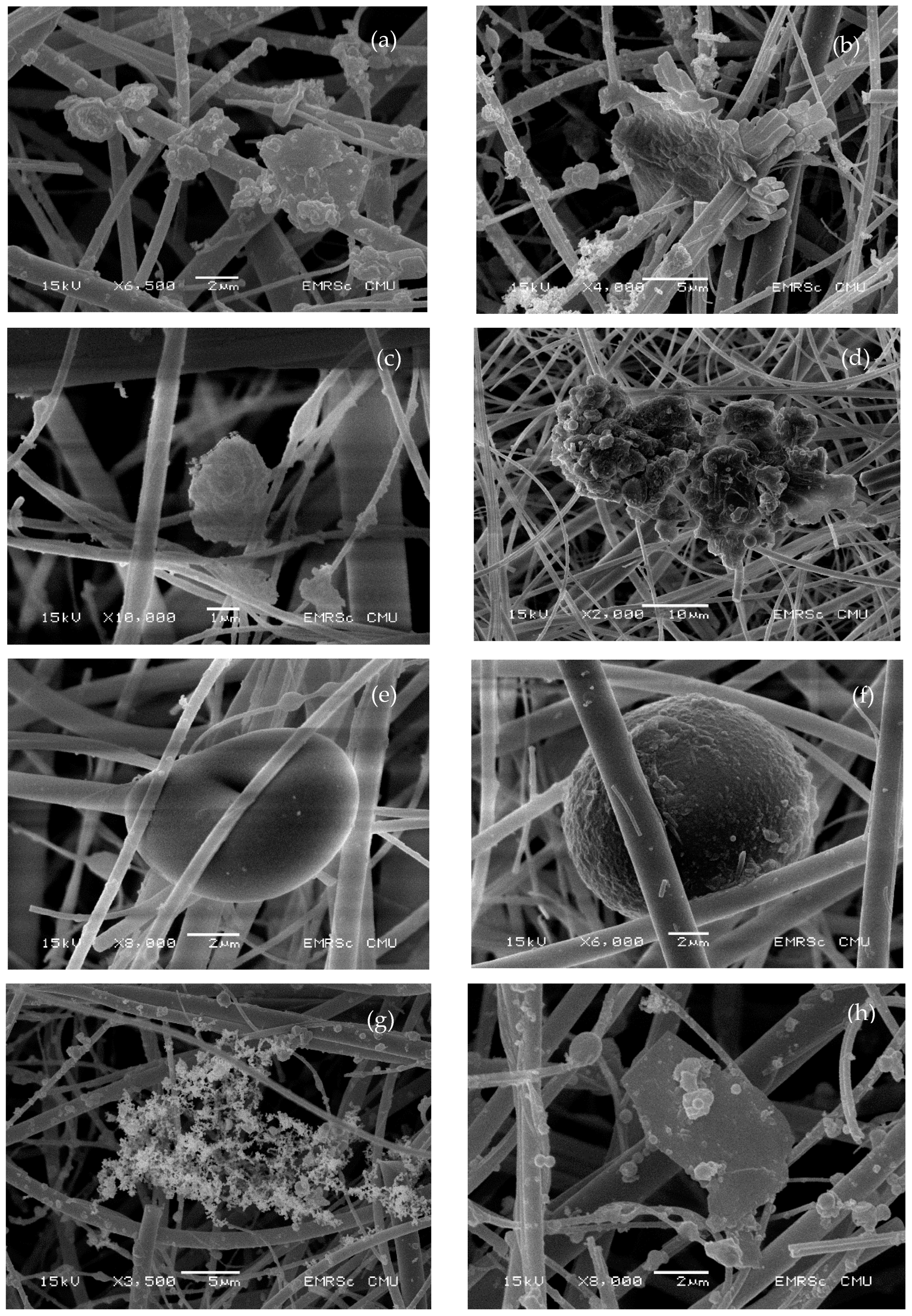
| Heavy Metals | Component | |
|---|---|---|
| 1 | 2 | |
| As | 0.033 | 0.642 |
| Cd | 0.504 | 0.586 |
| Cr | 0.255 | 0.762 |
| Cu | 0.883 | 0.339 |
| Fe | 0.977 | 0.135 |
| K | 0.401 | 0.507 |
| Mn | 0.934 | 0.320 |
| Ni | 0.018 | 0.760 |
| Pb | 0.971 | 0.162 |
| V | 0.303 | 0.687 |
| Zn | 0.984 | 0.122 |
| Eigenvalues | 6.23 | 1.78 |
| % of Variance | 46.3 | 26.5 |
| Cumulative % | 46.3 | 72.8 |
| Estimate sources | Industrial sources | Traffic sources |
| Elements | RfC * (mg/m3) | HQ | ||
|---|---|---|---|---|
| Baby (≥2 y) | Children (2–15 y) | Adults (16–70 y) | ||
| As | 1.5 × 10−5 | 2.69 × 10−2 | 2.69 × 10−2 | 2.69 × 10−2 |
| Cd | 1.0 × 10−5 | 5.73 × 10−2 | 5.73 × 10−2 | 5.73 × 10−2 |
| Cr | 1.0 × 10−4 | 9.07 × 10−2 | 9.07 × 10−2 | 9.07 × 10−2 |
| Ni | 1.4 × 10−5 | 1.06 × 10−1 | 1.06 × 10−1 | 1.06 × 10−1 |
| Pb | 3.5 × 10−3 ** | 3.91 × 10−3 | 3.91 × 10−3 | 3.91 × 10−3 |
| V | 1.0 × 10−4 | 3.12 × 10−3 | 3.12 × 10−3 | 3.12 × 10−3 |
| Cu | 4.0 × 10−2 ** | 7.95 × 10−5 | 7.95 × 10−5 | 7.95 × 10−5 |
| Fe | 7.0 × 10−1 ** | 1.70 × 10−4 | 1.70 × 10−4 | 1.70 × 10−4 |
| Mn | 5.0 × 10−5 | 1.90 × 10−1 | 1.90 × 10−1 | 1.90 × 10−1 |
| Zn | 3.0 × 10−1 ** | 8.85 × 10−4 | 8.85 × 10−4 | 8.85 × 10−4 |
| HI | 3.88 × 10−1 | 3.88 × 10−1 | 3.88 × 10−1 | |
| Elements | IUR * (Per µg/m3) | CRinh | ADAFs | TCRinh | ||||
|---|---|---|---|---|---|---|---|---|
| Baby (≥2 y) | Children (2–15 y) | Adults (16–70 y) | CRbaby | CRchildren | CRadults | |||
| As | 0.0043 | 4.95 × 10−8 | 3.47 × 10−7 | 1.36 × 10−6 | 1.38 × 10−8 | 2.03 × 10−7 | 1.04 × 10−6 | 1.29 × 10−6 |
| Cd | 0.0018 | 3.05 × 10−8 | 2.13 × 10−7 | 8.39 × 10−7 | 8.71 × 10−9 | 1.28 × 10−7 | 6.59 × 10−7 | 7.96 × 10−7 |
| Cr | 0.084 1 | 2.18 × 10−5 | 1.52 × 10−4 | 5.98 × 10−4 | 6.22 × 10−6 | 9.14 × 10−5 | 4.70 × 10−4 | 5.68 × 10−4 |
| Ni | 0.00024 | 9.98 × 10−9 | 6.99 × 10−8 | 2.74 × 10−7 | 2.94 × 10−9 | 4.32 × 10−8 | 2.22 × 10−7 | 2.68 × 10−7 |
| Pb | 0.000012 | 4.69 × 10−9 | 3.28 × 10−8 | 1.29 × 10−7 | 1.34 × 10−9 | 1.97 × 10−8 | 1.01 × 10−7 | 1.22 × 10−7 |
| PM2.5 | 0.008 ** | 2.20 × 10−3 | 1.54 × 10−2 | 6.06 × 10−2 | 6.30 × 10−4 | 9.26 × 10−3 | 4.76 × 10−2 | 5.75 × 10−2 |
Publisher’s Note: MDPI stays neutral with regard to jurisdictional claims in published maps and institutional affiliations. |
© 2022 by the authors. Licensee MDPI, Basel, Switzerland. This article is an open access article distributed under the terms and conditions of the Creative Commons Attribution (CC BY) license (https://creativecommons.org/licenses/by/4.0/).
Share and Cite
Kawichai, S.; Bootdee, S.; Sillapapiromsuk, S.; Janta, R. Epidemiological Study on Health Risk Assessment of Exposure to PM2.5-Bound Toxic Metals in the Industrial Metropolitan of Rayong, Thailand. Sustainability 2022, 14, 15368. https://doi.org/10.3390/su142215368
Kawichai S, Bootdee S, Sillapapiromsuk S, Janta R. Epidemiological Study on Health Risk Assessment of Exposure to PM2.5-Bound Toxic Metals in the Industrial Metropolitan of Rayong, Thailand. Sustainability. 2022; 14(22):15368. https://doi.org/10.3390/su142215368
Chicago/Turabian StyleKawichai, Sawaeng, Susira Bootdee, Sopittaporn Sillapapiromsuk, and Radshadaporn Janta. 2022. "Epidemiological Study on Health Risk Assessment of Exposure to PM2.5-Bound Toxic Metals in the Industrial Metropolitan of Rayong, Thailand" Sustainability 14, no. 22: 15368. https://doi.org/10.3390/su142215368
APA StyleKawichai, S., Bootdee, S., Sillapapiromsuk, S., & Janta, R. (2022). Epidemiological Study on Health Risk Assessment of Exposure to PM2.5-Bound Toxic Metals in the Industrial Metropolitan of Rayong, Thailand. Sustainability, 14(22), 15368. https://doi.org/10.3390/su142215368






